Output Utilities and Data Visualization
Scenario Management
The Scenario Manager allows editing of a small portion of a RiverWare model without affecting the integrity of a baseline model. With the Scenario Manager, the values of a subset of slots can be altered independently of the baseline model. Models can be viewed and run using these various scenario values without corrupting the values in the baseline model. The Scenario Manager provides a convenient interface to load, edit, and save values for these slots, run the model using these different slot values, and compare the baseline values with the scenario values.
Introduction
This documentation describes the basic features of the Scenario Manager and how to construct scenarios.
• If you are creating a scenario baseline model, see “Baseline Model Creation”.
• If you are a stakeholder and want to make scenario runs, see “Creating, Editing, and Running Scenarios”.
The following definitions are used in this documentation.
Creator / Baseline Developer
The user who transforms a regular model into a Baseline model. This user selects the slots that will be changed and the slots to compare. He/she makes the baseline model run.
Scenario User / Stakeholder
The user(s) who loads a baseline model, creates a scenario, and runs the scenario. This is typically a stakeholder who wishes to run the model in a controlled fashion.
Baseline model
A model that cannot be directly edited by a user. A scenario user can apply different scenarios to a baseline model, but they cannot edit the data in the baseline model directly.
Scenario input slot list
The set of slots that can be edited. This is defined by the initial creator of the baseline model and cannot be edited other than changing values by scenario users.
Scenario output slot list
The set of interesting output slots. This is defined by the initial creator of the baseline model and cannot be edited.
Scenario
Alternative data for slots in the scenario input slot list which can be loaded into the model in order to perform model runs.
Baseline Model Creation
A baseline model must be created before any scenarios can be developed. The baseline model is generated by saving an existing model, with or without a ruleset, as a baseline model. Once a model has been saved as a baseline model, model topology, methods, rulesets, and non-scenario slots become protected from editing. The baseline model cannot be re-saved once it is created unless it is resaved as a non-baseline model. To maintain the integrity of the baseline model, we do not recommend re-saving the model as non-baseline. Following are the steps to create a baseline model from a regular model; these steps are described in detail in the remainder of this chapter:
1. Open a regular model and optionally the ruleset. Open the Scenario Manager.
2. Select the list of Slots to Modify (Input Slots).
3. Select the list of slots that represent the Results to Compare (Output Slots).
4. Enter Baseline comments.
5. Optionally create a Scenario Sandbox.
6. Run the model.
7. Save as Baseline.
Open a Model, Ruleset, and Scenario Manager
To create a baseline model, open the desired model (and ruleset). Open the Scenario Manager from the Utilities, then Scenario Management menu on the main RiverWare menu.
This will open the Scenario Manager dialog. At this point, the dialog is empty because no slots have been specified. The title bar of the Scenario Manager says “[Not baseline model]” because no baseline scenario slots have been specified or saved.
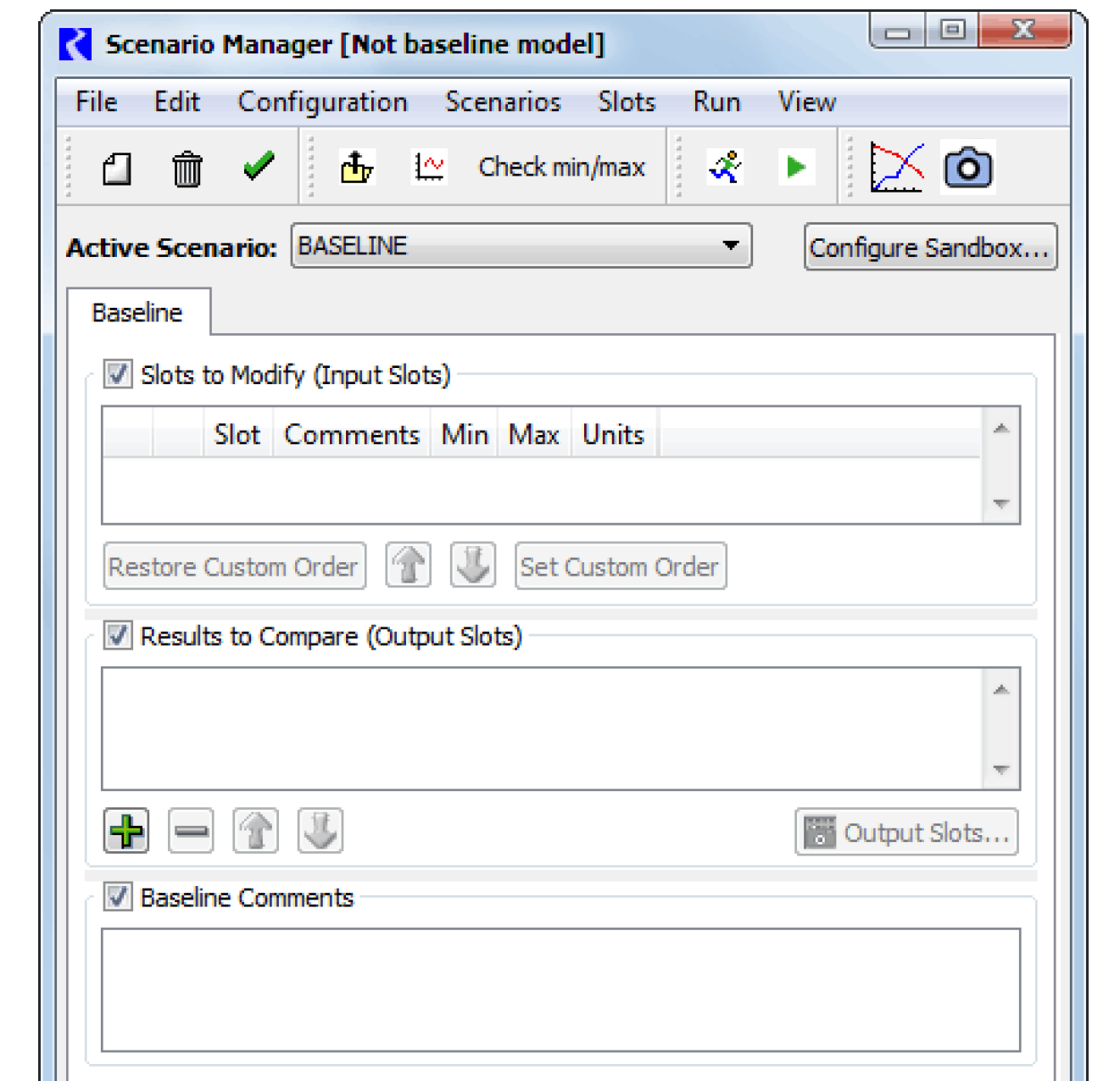
Specify Slots to Modify (Input Slots)
You will need to decide which slots are key to generating different scenarios. This subset of slots will be the only slots that scenario users are allowed to modify values or data to test various scenarios against the baseline scenario. To add the slots that form the baseline scenario select Configuration, then Add Input Slots.
Use the selector to choose the Scenario Input Slots. The added slots appear under the Slots to Modify (Input Slots).
As creator of the baseline, you can specify a minimum or maximum (or both) value that the slot is not allowed to violate in any scenario.
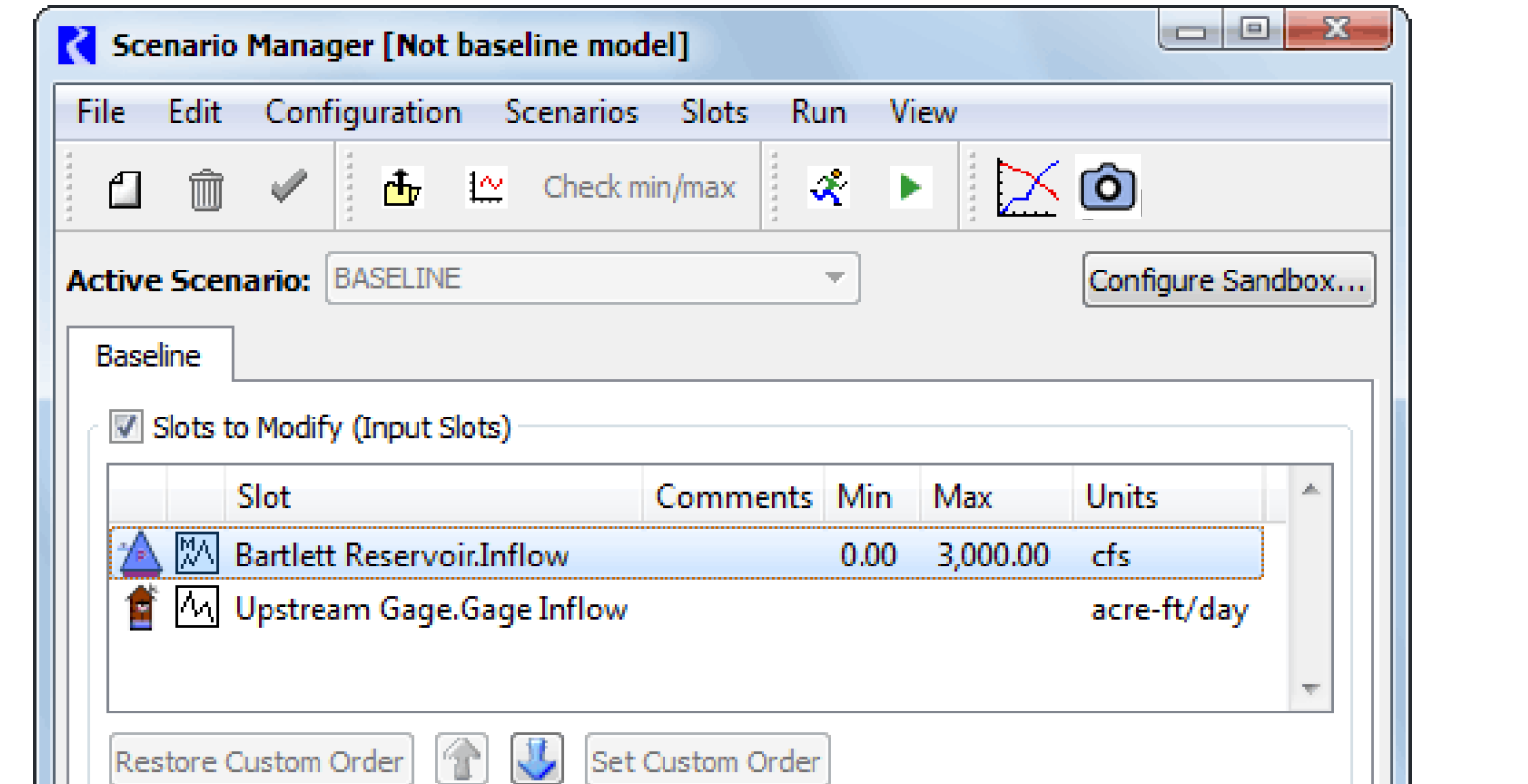
To specify a minimum or maximum slot value, highlight the slot and select Configuration, then Set Min Value or Configuration, then Set Max Value from the menu bar. A dialog window will appear. Enter a value and select the OK button. You can also use the Configuration, then Compute Min/Max Values from Baseline Slots to give you the existing bounds. Once this value is set, it cannot be altered by scenario users.

Comments can also be added to the individual slots in the comment field to the right of the slot name and to the scenario in the scenario comment field. To enter a slot comment, highlight the desired slot and single select the Comment field next to the slot name. A text cursor will appear. Enter the desired comment.
The list of slots can be ordered in several ways. The current ordering of slots is saved with the model.
• To sort the slots by slot name, object name, slot type (series slot, table slot), and subbasin membership select the Slots column header at the top of the slots list. Sorting by subbasin is based on an alphabetized list of the user-defined subbasins which the slot is a member of.
• To sort the slots by the comments, minimum, or maximum values select the appropriate column header at the top of the slots list.
• To specify a custom slot order, highlight a slot and use the up and down arrows.
Specify Results to Compare (Output Slots)
Next, specify which output slots you would like to compare against the baseline and other scenarios. When a scenario run is made, a snapshot will be taken of each of these slots. Define the list of slots in the Results to Compare (Output Slots) slot list. This list is saved in the baseline model and is not modifiable by the stakeholder.
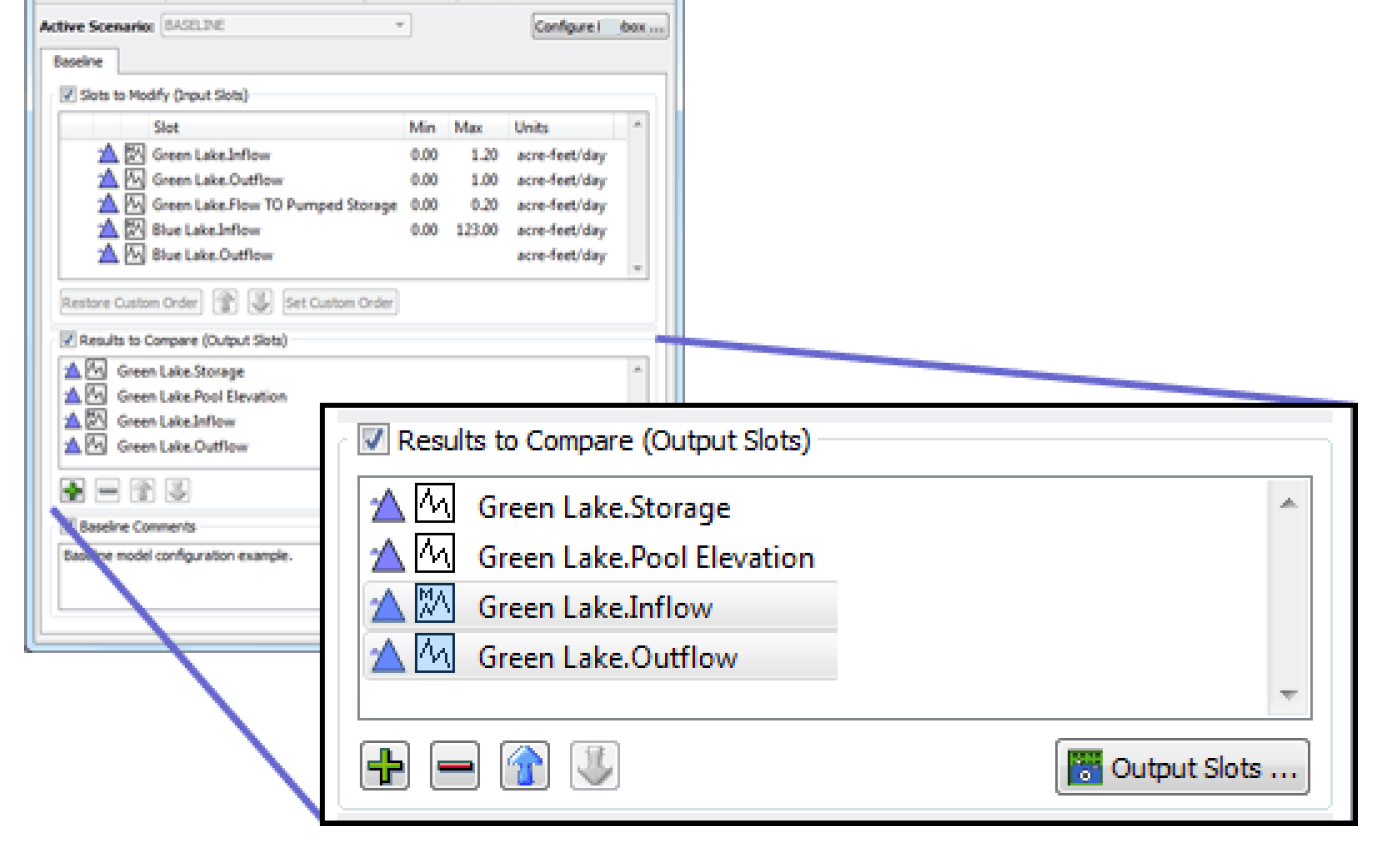
The green  button shows the general slot selector to pick more slots for this list.
button shows the general slot selector to pick more slots for this list.
 button shows the general slot selector to pick more slots for this list.
button shows the general slot selector to pick more slots for this list.The red  button removes the selected slots from this list.
button removes the selected slots from this list.
 button removes the selected slots from this list.
button removes the selected slots from this list.The blue  arrow buttons move the selected slot items up or down within the list. The order of the slots in the list will be the default order of slots within generated Scenario Output Snapshot Objects.
arrow buttons move the selected slot items up or down within the list. The order of the slots in the list will be the default order of slots within generated Scenario Output Snapshot Objects.
 arrow buttons move the selected slot items up or down within the list. The order of the slots in the list will be the default order of slots within generated Scenario Output Snapshot Objects.
arrow buttons move the selected slot items up or down within the list. The order of the slots in the list will be the default order of slots within generated Scenario Output Snapshot Objects.The Output Slots button  opens the BASELINE snapshot object which is automatically generated at the completion of a non-scenario run. This button is enabled only when that snapshot object exists within the workspace. If it is not enabled, make a run.
opens the BASELINE snapshot object which is automatically generated at the completion of a non-scenario run. This button is enabled only when that snapshot object exists within the workspace. If it is not enabled, make a run.
 opens the BASELINE snapshot object which is automatically generated at the completion of a non-scenario run. This button is enabled only when that snapshot object exists within the workspace. If it is not enabled, make a run.
opens the BASELINE snapshot object which is automatically generated at the completion of a non-scenario run. This button is enabled only when that snapshot object exists within the workspace. If it is not enabled, make a run.Enter Baseline Comments
To enter the baseline scenario comment, single select the Baseline Comment field and enter the desired text.
Create a Scenario Sandbox (Optional)
A Scenario Sandbox provides a convenient way for the scenario users (i.e. the stakeholders) to easily create and run scenarios and view results.
The configuration of the sandbox is defined by the baseline creator (i.e. scenario engineer) and the scenario user cannot change the configuration. The current implementation of the Scenario Sandbox supports the following functionality:
• A single sandbox configuration can be defined within a baseline model.
• Up to three input scenario slots can be adjusted by the stakeholder. Only series slots are supported.
• Slider controls are available to adjust the values of each of the three input scenario slots. Supported transformations from the baseline series values are as follows:
– Scaling: Multiplying by a factor
– Offsetting: Adding a positive or negative term specified in the display units for the slot
• The adjusted (scaled or offset) scenario values are automatically clipped at these minimum and maximum, if they are defined.
• Plotting of scenario output slots is shown in a plot panel within the sandbox. For a single selected slot among a set of scenario output slots, the plot panel shows the baseline series plus the generated scenario outputs for one or more selected scenarios.
Figure 8.1 shows a sample completed sandbox.
Figure 8.1
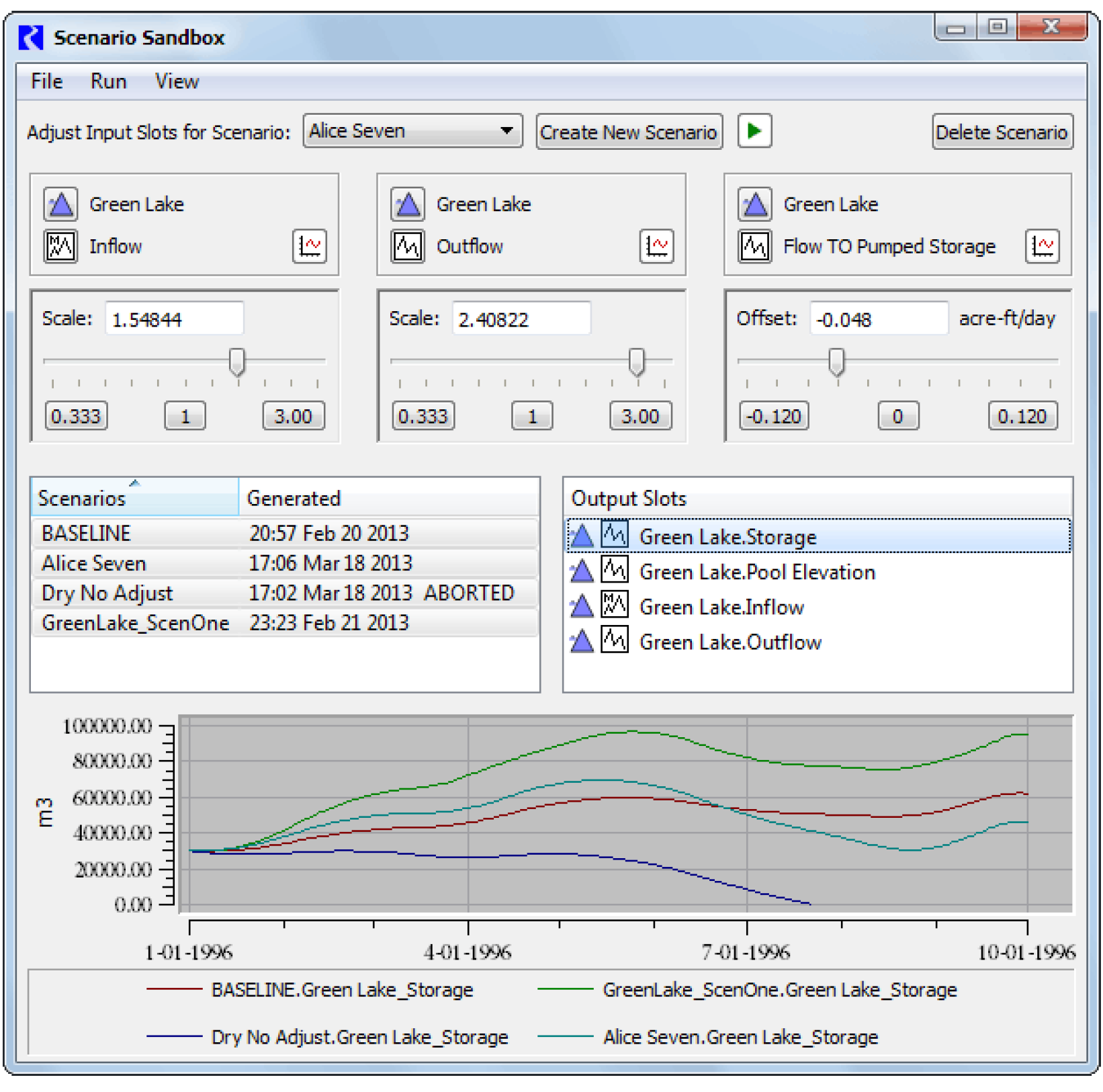
Use the Create Sandbox button in the Scenario Manager (available only in non-baseline models) to create a sandbox.
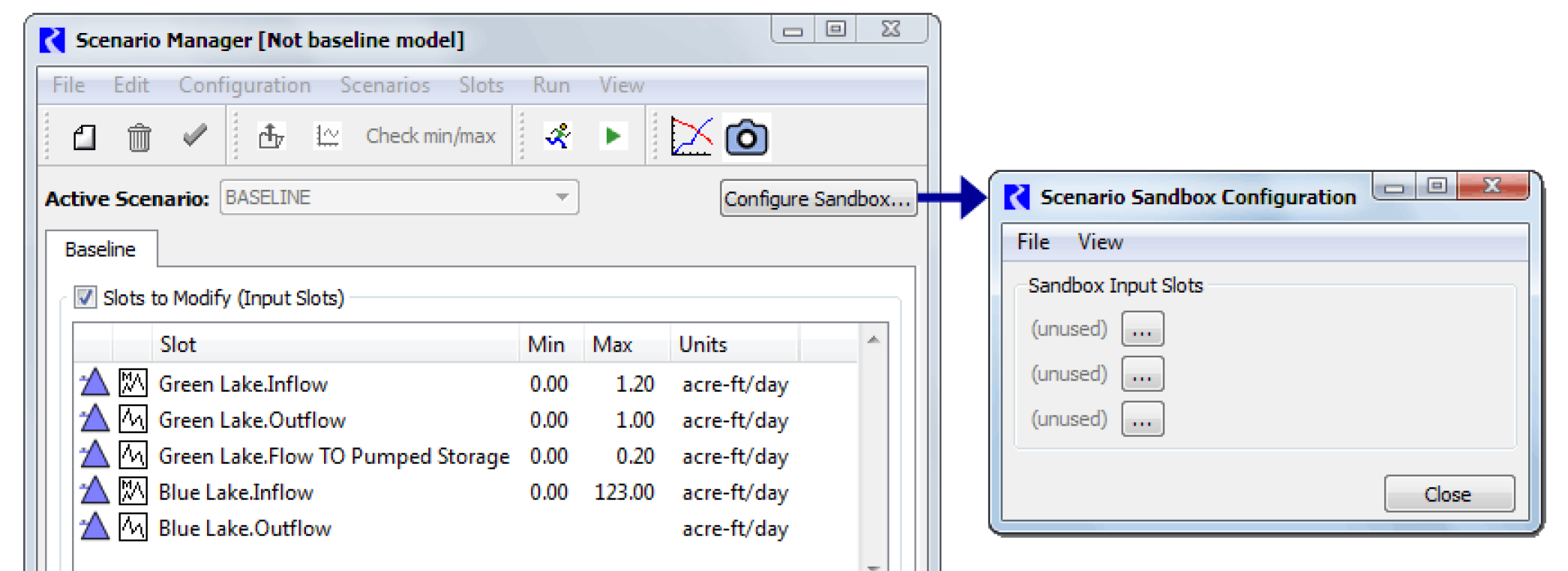
Configure the Scenario Sandbox by selecting up to three scenario input slots to be adjusted by the stakeholder in the sandbox. The configuration for each of these three slots consists of the following:
• Adjustment Mode. Whether the slot values are adjustable by scaling (multiplying by a factor) or by offsetting (increasing by a negative or positive amount).
• Limits for the adjustment parameters. These correspond to extreme ends of a slider control. The manner in which these limits are defined is devised such that the slider's mid-point represent no change.
– For scaling factor values, an upper limit (greater than 1.0) is specified; the lower limit will be the reciprocal of the upper limit.
– For offset term values, a positive upper limit is specified; the lower limit will be the negative of the upper limit.
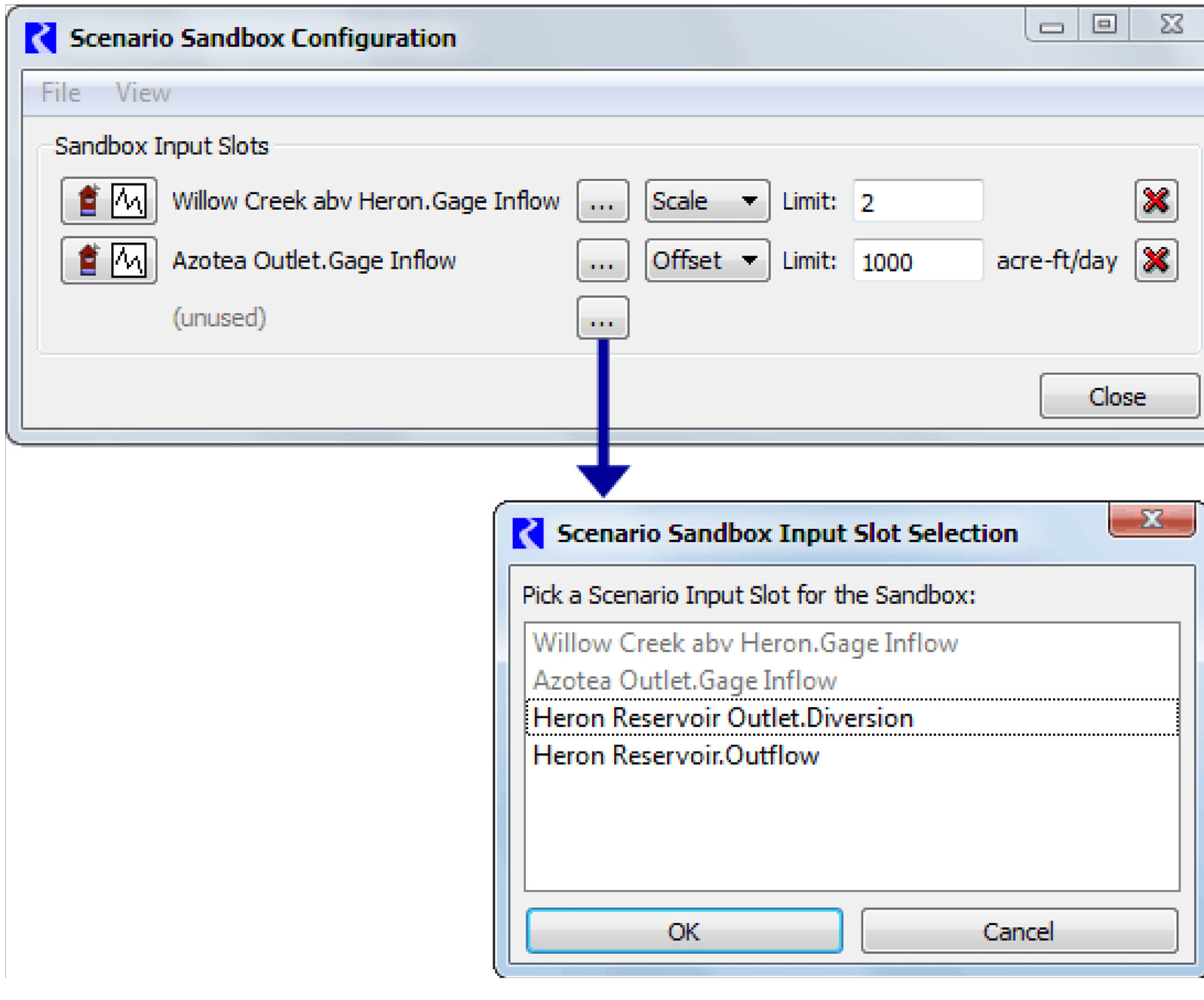
Note: When a scenario input slot has been included in a sandbox configuration, its values are no longer directly editable, e.g. in its Open Slot dialog or an SCT. (Such slots’ values will be “read-only” in those dialogs). This is necessary because the values of such a scenario input slot are computed using a linear function on its corresponding baseline slot. However, for individual scenarios within the RiverWare session, the sandbox adjustments can be disabled so that all Scenario Input Slots can be modified in the conventional way.
Run
After configuring the Scenario Manager and the Scenario Sandbox, it is critical that you run the model. This generates the BASELINE output and a new snapshot object is created. These are the data against which all scenario results are compared.
Note: To reiterate, run the model.
Save as Baseline
When you are finished with the configuration, save the entire RiverWare model as a baseline model. This will preserve the baseline scenario slots in the Scenario Manager and ensure that other users are not able to modify the model further, unless they specifically resave the baseline model as non-baseline.
• To save the model as a baseline model, select File, then Save As Baseline from the main RiverWare menu bar. This will preserve the scenario slot list and all configurations in the Scenario Manager.
To help document the baseline model, you will be prompted with the Model File Info dialog. A comment about the date, time, and username saving the model as a baseline is added to the end of the comment by default. This comment field can be freely edited by the user before saving the model as a baseline.
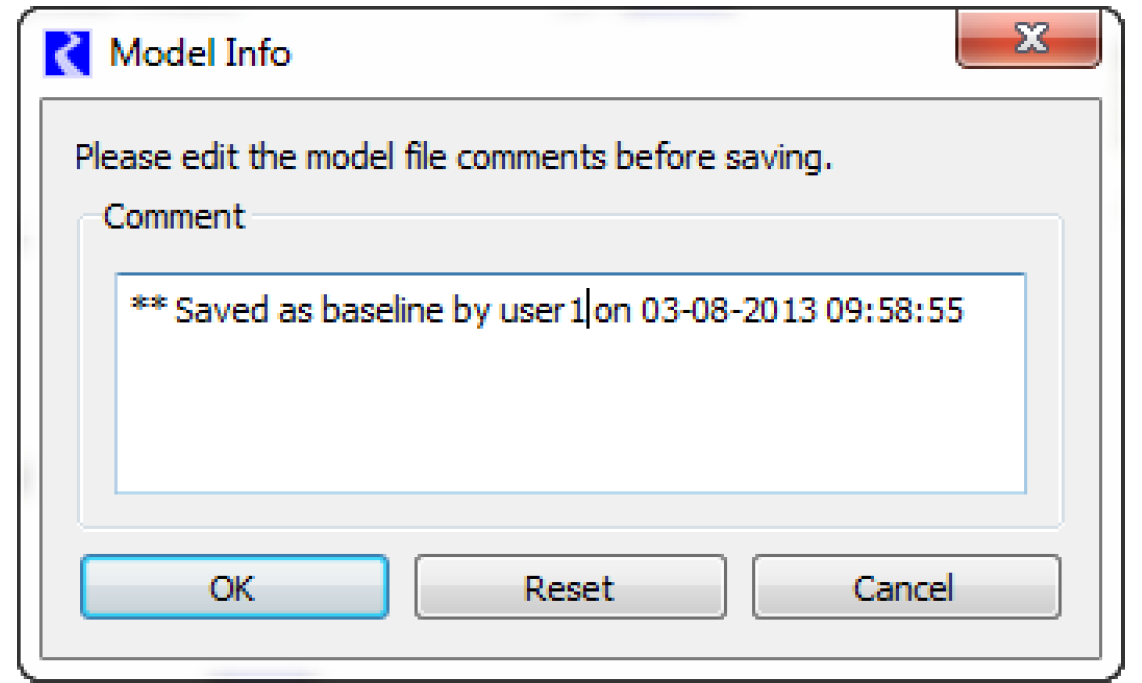
Once the model has been saved as a baseline model, “[Scenario: BASELINE]” will appear next to the model name in the main RiverWare workspace. The Scenario Manager will also indicate that the model has been saved as a baseline model.
You can now distribute the model to stakeholder scenario users.
Creating, Editing, and Running Scenarios
After the creation of a baseline model, no slots can be added or deleted from the scenario slot list. This is done to preserve the integrity of the baseline model.
Note: From this point forward, this document assumes you are a scenario user (i.e. a stakeholder) and you are making scenario runs.
You have the following options:
• Use a sandbox (if configured) to define and make scenario runs and compare results (easiest option, but limited controls). A sandbox has been configured if the Scenario Sandbox button appears on the bottom of the main RiverWare workspace. See “Scenario Sandbox” for details.

• Configure the scenarios yourself. Then run and compare results yourself (harder option, but more controls). See “Full Control of Scenarios” for details.
Scenario Sandbox
The Scenario Sandbox is accessible from the RiverWare Workspace and from the Scenario Manager. If a Scenario Sandbox has been configured,
• A Scenario Sandbox button appears on the Workspace’s status bar, as shown above
• On the workspace, the Utilities, then Scenario Sandbox menu item is shown.
Scenario Sandbox Controls Overview
The Scenario Sandbox presents all the functionality necessary to create and run a scenario within a baseline model.
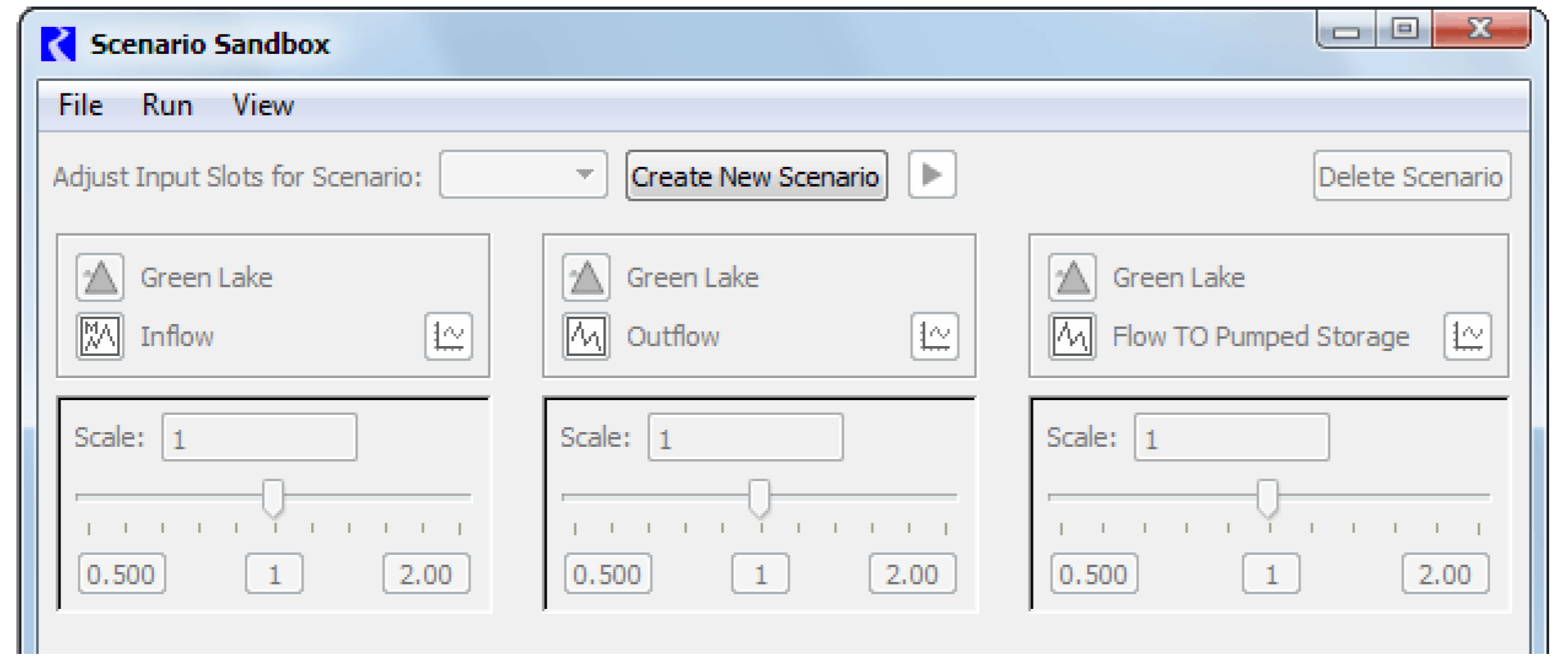
Create a new scenario
Select the Create New Scenario button and enter a new name for the scenario.
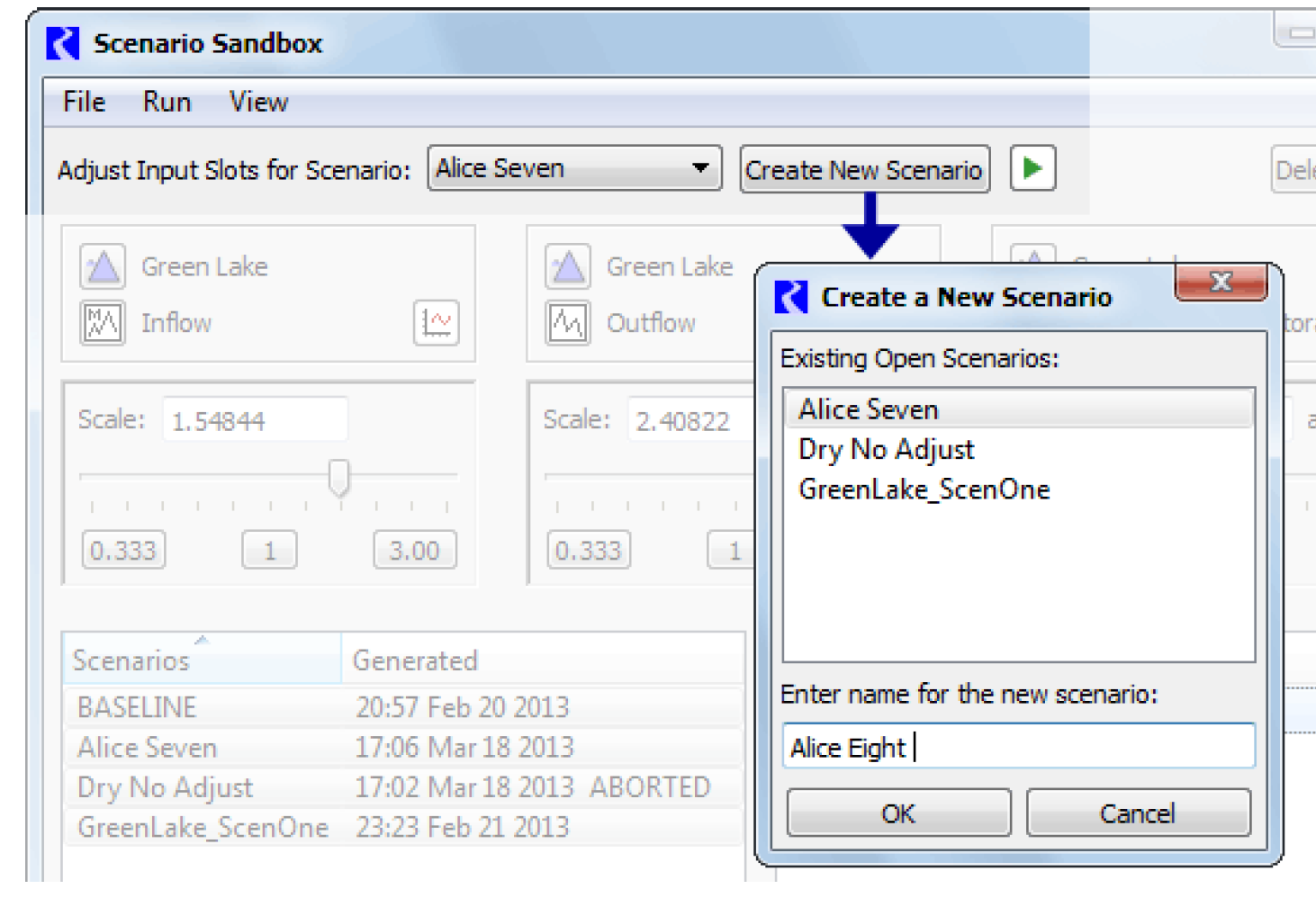
Open an existing scenario
Use the File, then Open Scenario menu to open an existing, previously saved scenario.
You switch between opened scenarios using the pull-down menu.
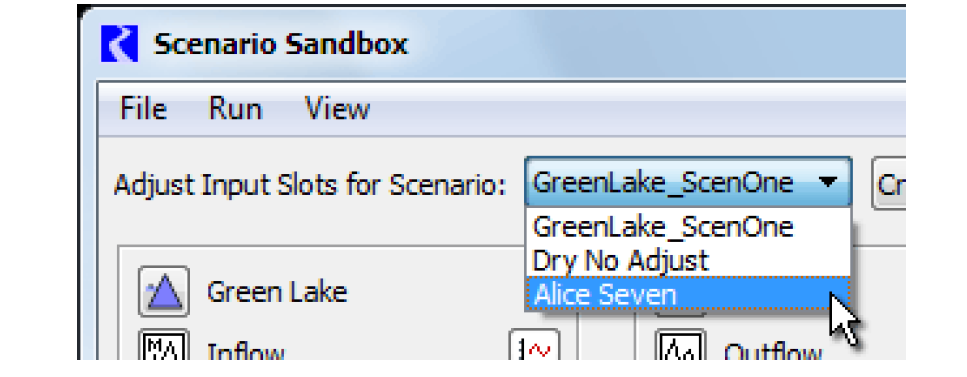
Scenario Sandbox Input Adjustment Controls
Next adjust values using the sliders for up to three scenario input slots. Changes to the sliders effect those input slots of the currently selected scenario.
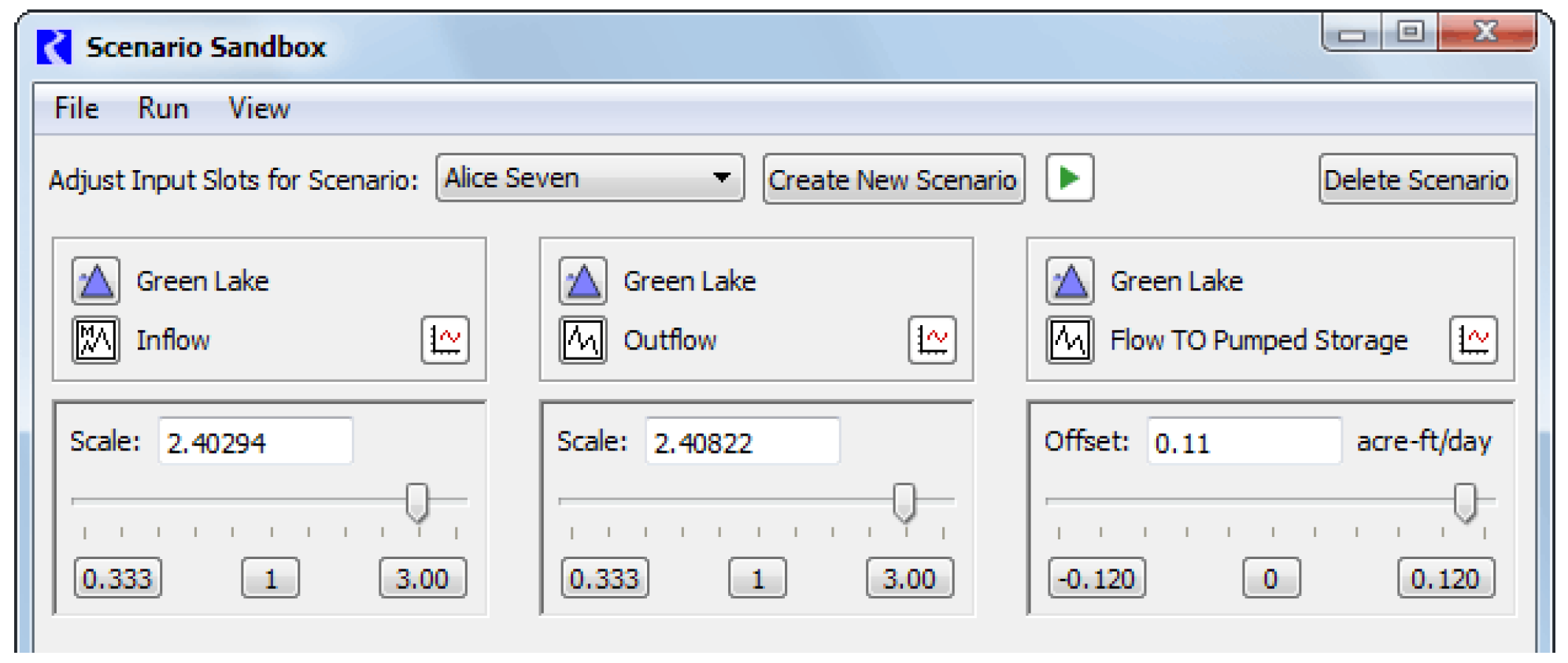
Each input slot panel contains the following controls:
• Slot Name, including type icons and names of the containing object and the slot.
• A plot button to show a plot dialog with both the adjusted scenario slot values and its baseline slot values. If minimum and/or maximum limits are configured for the scenario slot, those limits are shown as horizontal markers in the plot.
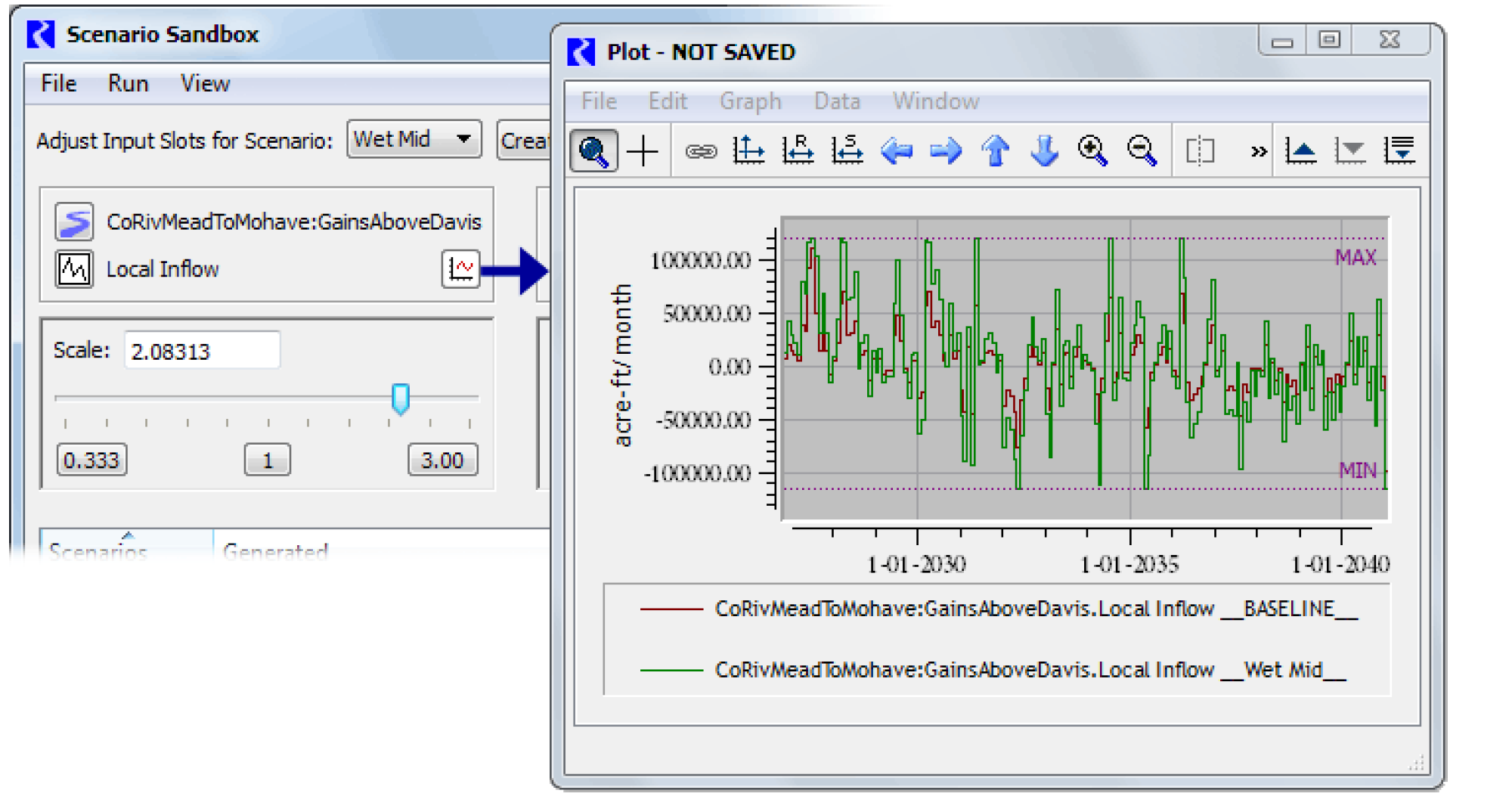
• A slider panel, of either the scale or offset type. Each includes the following:
– A numeric field showing the value of the current slider position. The field is directly editable; editing the value sets the position of the slider.
– A horizontal slider control.
– Three numerically labeled buttons. See description below.
The Scale sliders are exponential. The range is based on the upper value set by the scenario engineer. The lower limit of the range is the reciprocal of the specified upper value. The mid-point is always “1”, which results in no difference from the baseline slot values.
Note: Although the scale slider bar’s positions are interpreted exponentially, the slider’s tick marks are evenly spaced.
The Offset sliders are linear, and range from the negative value to the positive value of the adjustment limit value set by the scenario engineer. The midpoint is always zero, which results in no difference from the baseline slot values. The Offset values are in the slot display units.
Note: Offsets are applied in user-units; therefore, in the case of irregular time units, such as acre-feet per month, the adjustment to the underlying standard values (e.g. cms) is different depending on the month or year in which the timestep occurs.
The computed scenario slot values are clipped at the configured minimum and maximum values for the baseline slot, if those have been configured.
Note: This is not considered an error condition.
Note: These minimum and maximum values should not be confused with the adjustment limit values which apply to the coefficients of the linear adjustment transform function. These minimum and maximum values are applied to the results of that function.
Scenario Sandbox Output Plot Controls
The bottom section of the Scenario Sandbox shows generated scenario results (outputs). Output controls consist of three components:
• A list of the generated scenarios.
• A list of the sandbox's scenario output slots.
• A plot of the selected slots for each scenario selected.
The plot is dynamically updated as the selections in the two lists are changed. A curve is shown for each of the selected scenarios' value of the single selected output scenario slot. A curve for the baseline slot is always shown.
Only scenarios for which a scenario snapshot object has been generated are shown with a “Generated” timestamp. Double-clicking an item on the Generated Scenarios list shows the Open Object Dialog for that snapshot. Figure 8.2 illustrates.
Figure 8.2
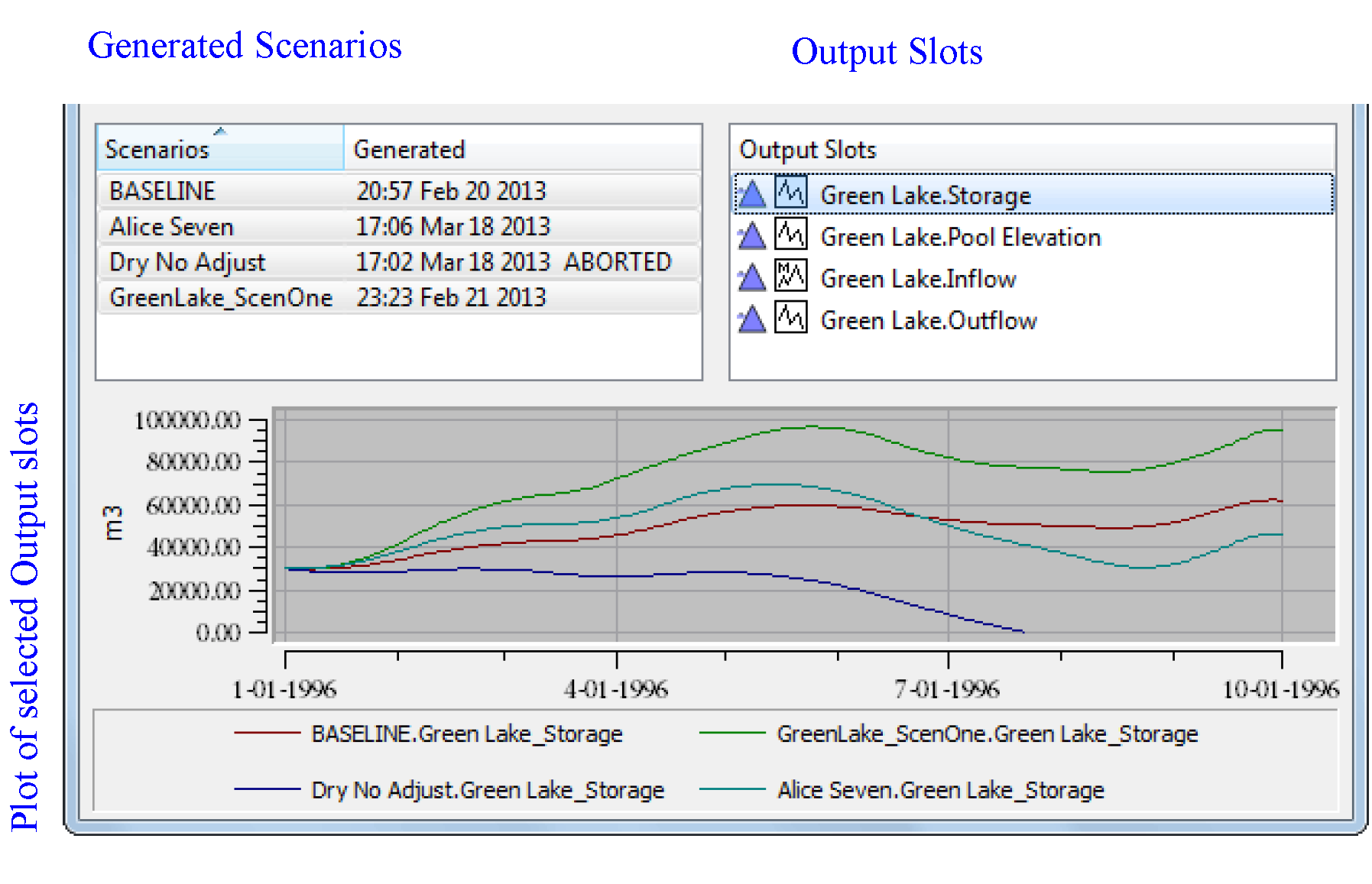
Once a new scenario has been created, it must be saved. Use the File, then Save Scenario As and save the scenario in the desired directory. This can be loaded into subsequent BASELINE model runs for additional analysis.
Disabling the Sandbox
For any particular scenario, full editing of Scenario input slots can be made available by unchecking the checkbox to the left of the Sandbox button on the Scenario Manager. When re-enabling the Sandbox for a scenario, if doing so would effect the values of those input slots, this warning message popup is displayed, providing the option to keep the Sandbox disabled (and preserve the scenario’s input slot values).
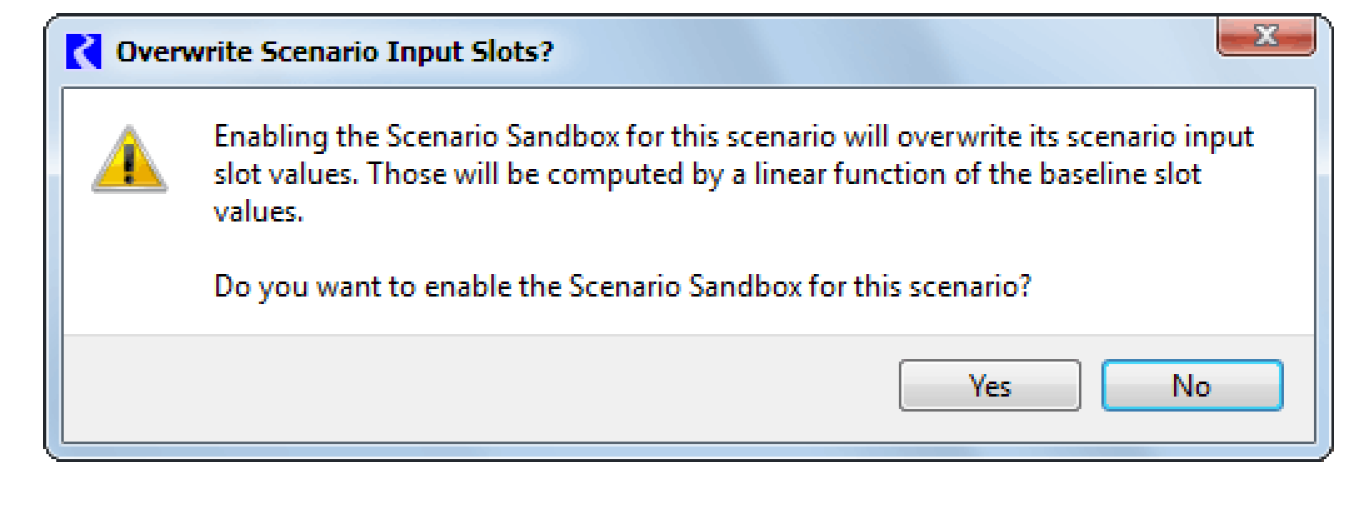
Full Control of Scenarios
When a sandbox is not configured or you would like to change more than 3 input slots, you can create a scenario and have more control over the inputs. New scenarios to test permutations of the model can only use the slots specified in the scenario slot list, and all input values must fall within the minimum or maximum constraints (if any) set on the slot.
• To create new scenarios, select Scenarios, then New Scenario from the Scenario Manager menu bar or select the New Scenario button. 

A tab with the name of the new scenario will be added next to the baseline tab in the Scenario Manager. Selecting the tabs allows you to toggle between the baseline scenario and other scenarios.
The name of the scenario corresponds to the scenario file’s name. A newly created scenario will have the default name “Unsaved Scenario.”
• To change the name of a scenario:
Select File, then Save Scenario As from the Scenario Manager menu bar. This will add an additional line to the Scenario Comments field indicating the new name of the scenario file.
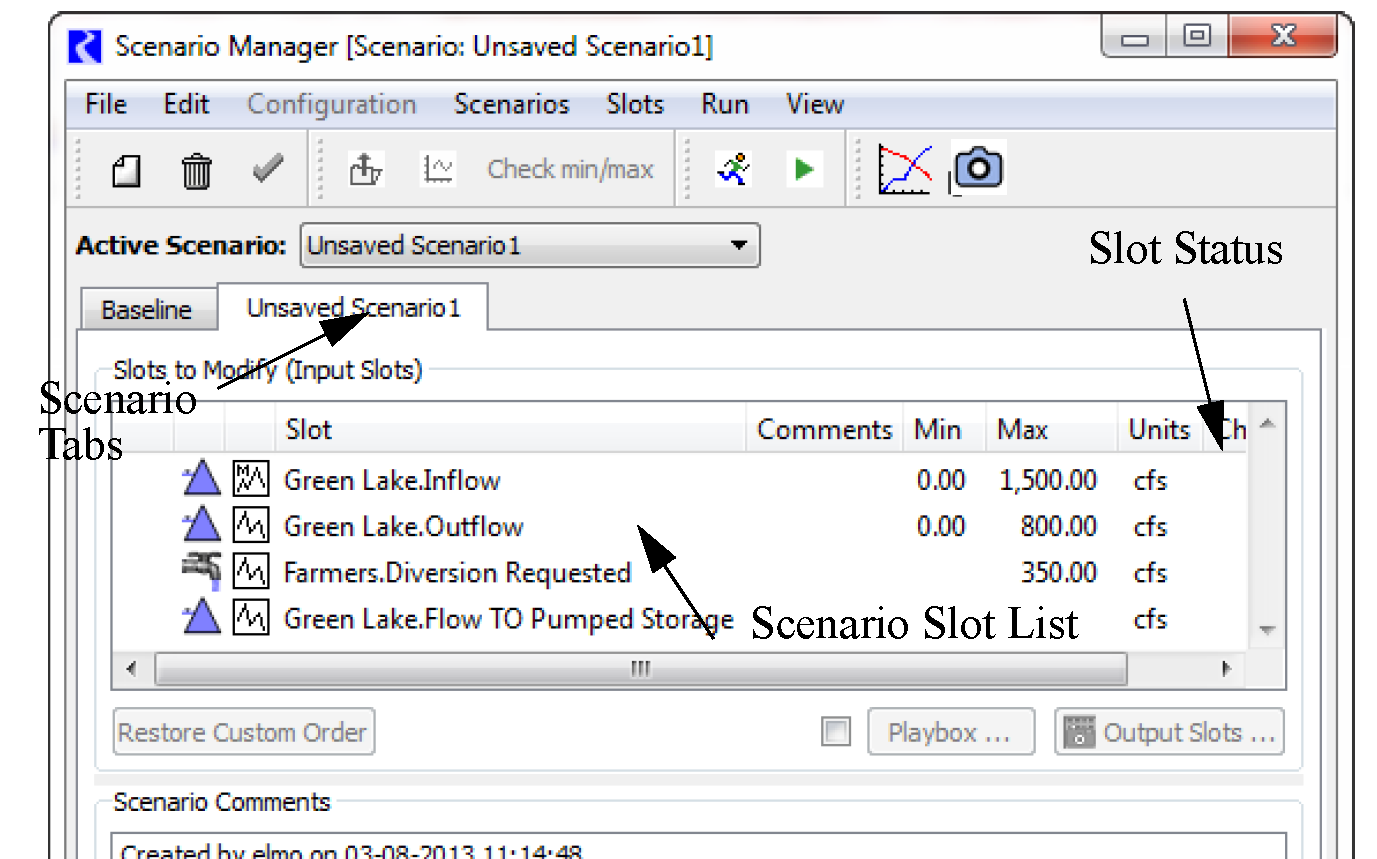
• To input new values into a slot in the scenario slot list and create model permutations:
Highlight the slot to which you wish to input values and double select the slot name, select Slots, then Open Slot, or select the Open Slot button in the Scenario Manager toolbar. 

This will bring up the open slot dialog window. You can then import a data file or enter new values by hand for select timesteps or the entire timeseries. Once the slot values have been altered, “Yes” will appear in the slot status Changed field of the Scenario Manager.
• To scale all the values on a slot, select Slots, then Scale Slot. The values in all the rows and/or columns in the slot will be multiplied by the given scaling factor.
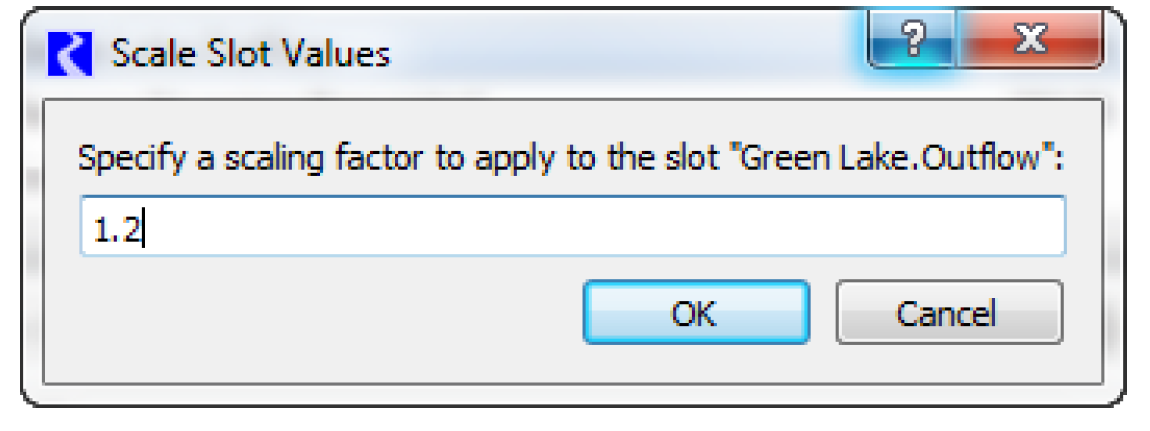
• To restore a slot’s values to the original baseline data, select Slots, then Fill With Baseline Values.
• To ensure that the values entered fall within the minimum or maximum constraints set on the slot, select Scenarios, then Check Min/Max or select the Check Min/Max button. 

A dialog window will appear, indicating whether or not the new scenario contains valid values.
Once a new scenario has been created, it must be saved. The first time a scenario is created, it must be saved with the Save Scenario As option. Subsequent saves can use the Save Scenario option.To save a new scenario:
• Select File, then Save Scenario As and save the scenario in the desired directory.
Finally, a convenient way to compare the differences between a slot in various scenarios is to plot the slot against either the baseline slot values or against the values of the slot in other scenarios. You can also plot the slot for a single scenario only. All the plotting options are located in the menu bar of the Scenario Manager under Slots, then Plot Slot, Slots, then Plot Slot + Baseline, or Slots, then Plot Slot on All Scenarios. The slots are plotted in the familiar RiverWare Plot dialog with all features of the Plot dialog active. A sample graphic is provided below, which compares the selected scenario slot with the baseline slot values. The scenario slot name is distinguished from the baseline slot name by the convention: Slot Name_Scenario Name_.
Running a scenario is fairly straight forward. The scenario with which you wish to run the model must be active. Open scenarios by selecting File, then Open Scenario.
• To make a scenario active, toggle to the desired scenario in the Active Scenario field.
The Scenario Manager will verify that all the slots in the scenario are within the specified minimum/maximum values. If any of the bounds are exceeded, a warning message will be displayed to confirm that this scenario should be loaded.
A confirmation dialog will then appear, explaining to the user that the slot values in the selected scenario will overwrite the current data in the model. If this is not the intended action, the process can be canceled, and the scenario will not be loaded.
Upon activating a scenario, the Diagnostics Output Window will appear with an informational message displaying which scenario is currently active.
There are two options for running an active scenario:
• Select the Start Run button  in the Scenario Manager toolbar or select Run, then Start Run from the menu bar.
in the Scenario Manager toolbar or select Run, then Start Run from the menu bar.
 in the Scenario Manager toolbar or select Run, then Start Run from the menu bar.
in the Scenario Manager toolbar or select Run, then Start Run from the menu bar.• To run the scenario through the Run Control dialog, select the Run Control button in the Scenario Manager toolbar or select Run, then Run Control Dialog from the menu bar.

Comparing Scenario Runs
The Scenario Manager allows for comparisons between slots in the baseline scenario run and various scenario runs or between slots in the various scenario runs. Comparisons are managed through the Snapshot Manager and the Output Manager, which can be accessed through the Scenario Manager.
• To open the Output Manager, select View, then Output Manager from the menu bar of the Scenario Manager or select the Output Manager button in the toolbar. 

• To open the Snapshot Manager, select View, then Snapshot Manager from the menu bar of the  Scenario Manager or select the Snapshot Manager button in the toolbar.
Scenario Manager or select the Snapshot Manager button in the toolbar.
 Scenario Manager or select the Snapshot Manager button in the toolbar.
Scenario Manager or select the Snapshot Manager button in the toolbar.Making Scenario Runs
A snapshot object, or Scenario Output Snapshot Object, is automatically created after each scenario run (and also for the baseline run) to capture the values of a prescribed list of slots which generally represent outputs from the run. These new snapshot objects include copies of slots prescribed by the Scenario Engineer.
The association between a scenario and its output snapshot object is based only on the scenario and the object having the same name. This snapshot object will be saved with the scenario when the scenario is saved as a scenario file.
The background color of the snapshot object icon distinguishes the two types of snapshot objects:
• Yellow: Conventional snapshot object created by the user within the Snapshot Manager.
• Green: Scenario Output Snapshot Object automatically created at the end of a baseline or scenario run.
If the Results to Compare (Output Slots) slot list described above is not empty, then, each time a run finishes or aborts, a Scenario Output Snapshot Object having the same name as the active scenario (or else, “BASELINE” in a non-scenario run) is created (or re-created) with the following data:
• Non-editable copies of the slots enumerated in the Results to Compare (Output Slots) list,
• Automatically generated comments in the snapshot object’s description indicating the following:
– A timestamp of the run completion.
– A list of scenario input slots which have modifications with respect to the baseline values.
– For scenario sandbox adjusted slots, also the scale or offset value with which the scenario input slot’s values were computed.
The automatically generated text lines within the snapshot object’s description begin with a special character (“>”) to distinguish them from user-entered comments. All such lines are deleted from the description before generating new comment lines.
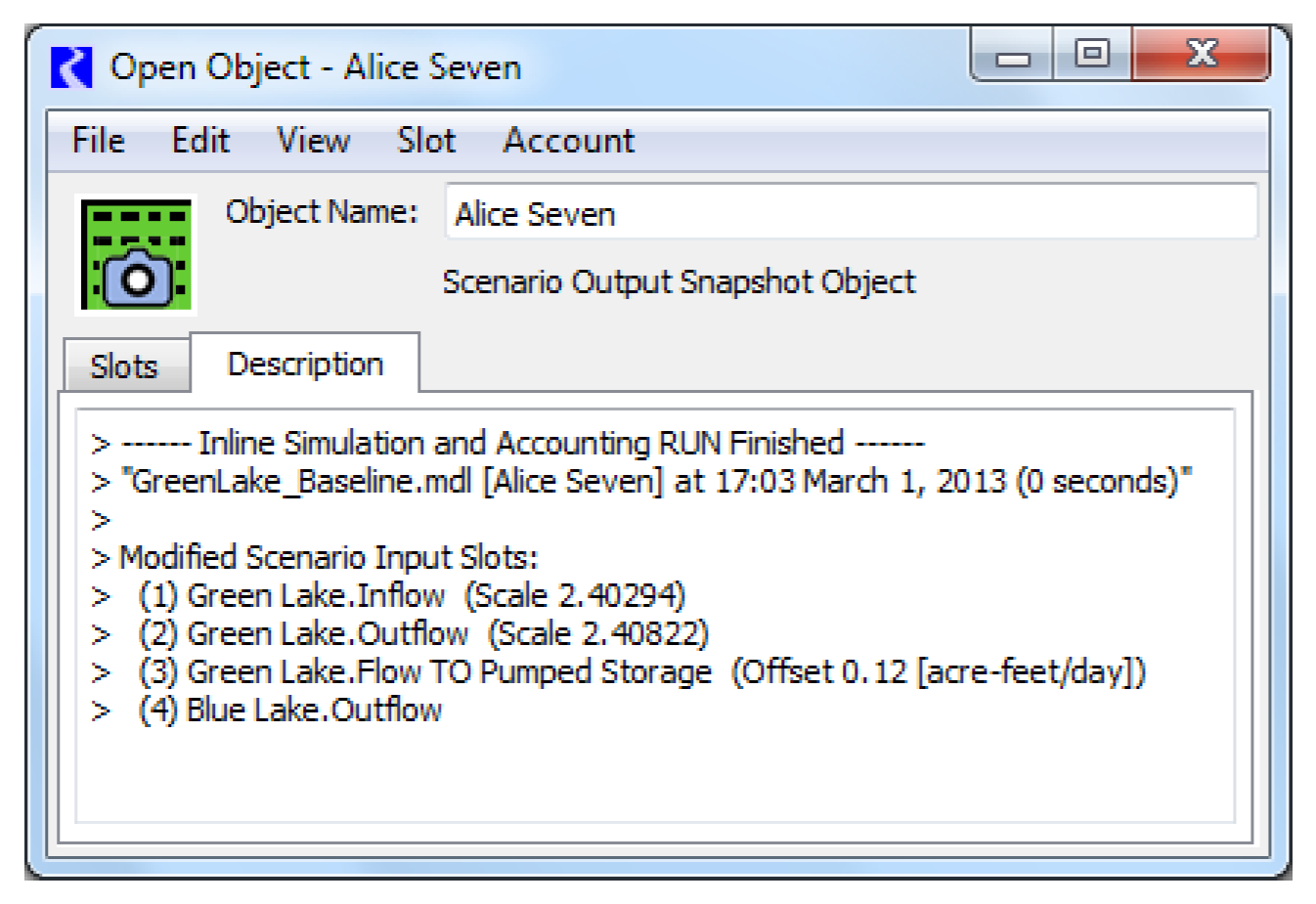
Accessing Scenario Output Snapshot Objects
The Open Object Dialog for the scenario’s output snapshot object can be shown by selecting the Output Slots button on the scenario’s tab in the Scenario Manager dialog or in the Scenario Sandbox; see “Scenario Sandbox” for details. These buttons are disabled if that snapshot object has not yet been generated.
Also, all existing Scenario Output Snapshot Objects are listed in the Snapshot Manager Dialog, with the snapshot items having a green-background snapshot icon.
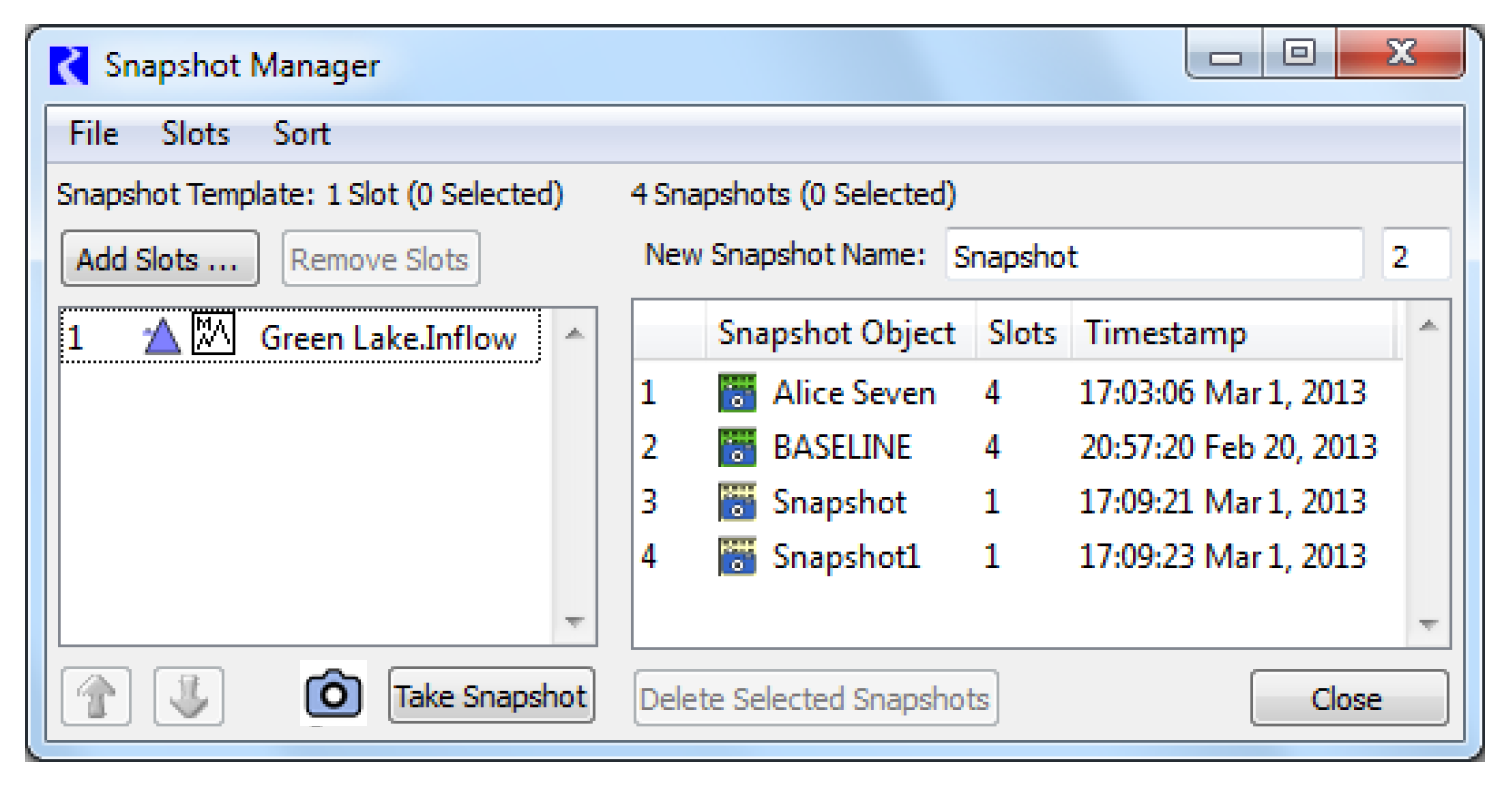
Scenario Output Snapshot Object Persistence in Scenario Files
Scenarios are saved in their own files, apart from the baseline model. The scenario’s output snapshot object is also saved in that file. When loading a scenario file, the snapshot object is loaded. This will replace any existing snapshot object on the workspace having the same name.
Saving Scenario Runs
To save the current contents of the model after running a scenario, the model must be saved as a non-baseline model. The resulting non-baseline model will only contain the current input/output values in the model; thus the baseline data will not be saved unless the baseline is the currently active scenario.
• To save the model as a non-baseline model, select File, then Save As Non-Baseline from the main Workspace menu bar.
A confirmation dialog will be presented, explaining that the saved model will no longer be a baseline model.
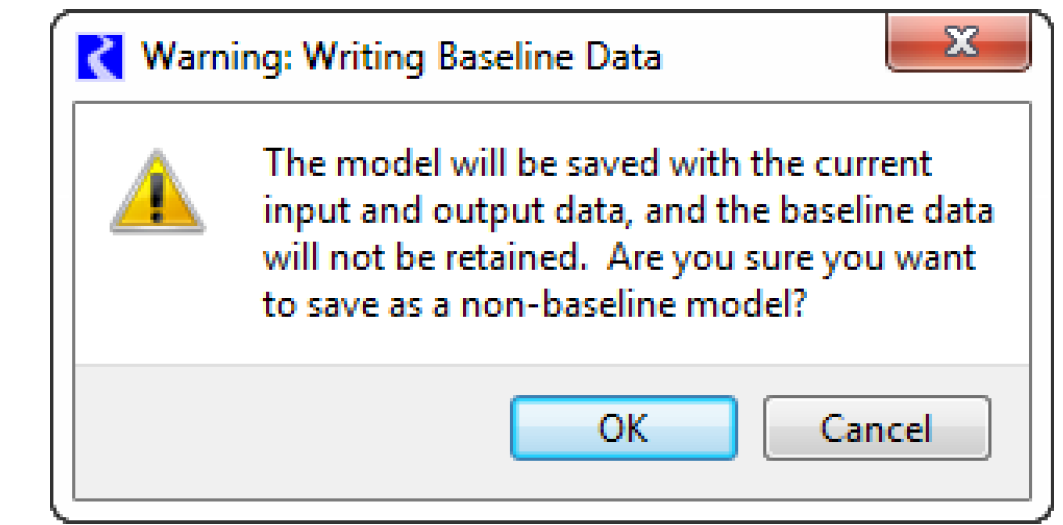
After confirming the save, the Model File Info dialog is presented so the user can document the scenario that is being saved in the model. By default, the comments from the scenario’s comment field will appear at the bottom of the Model File Comment field. This field can be freely edited before saving the model.
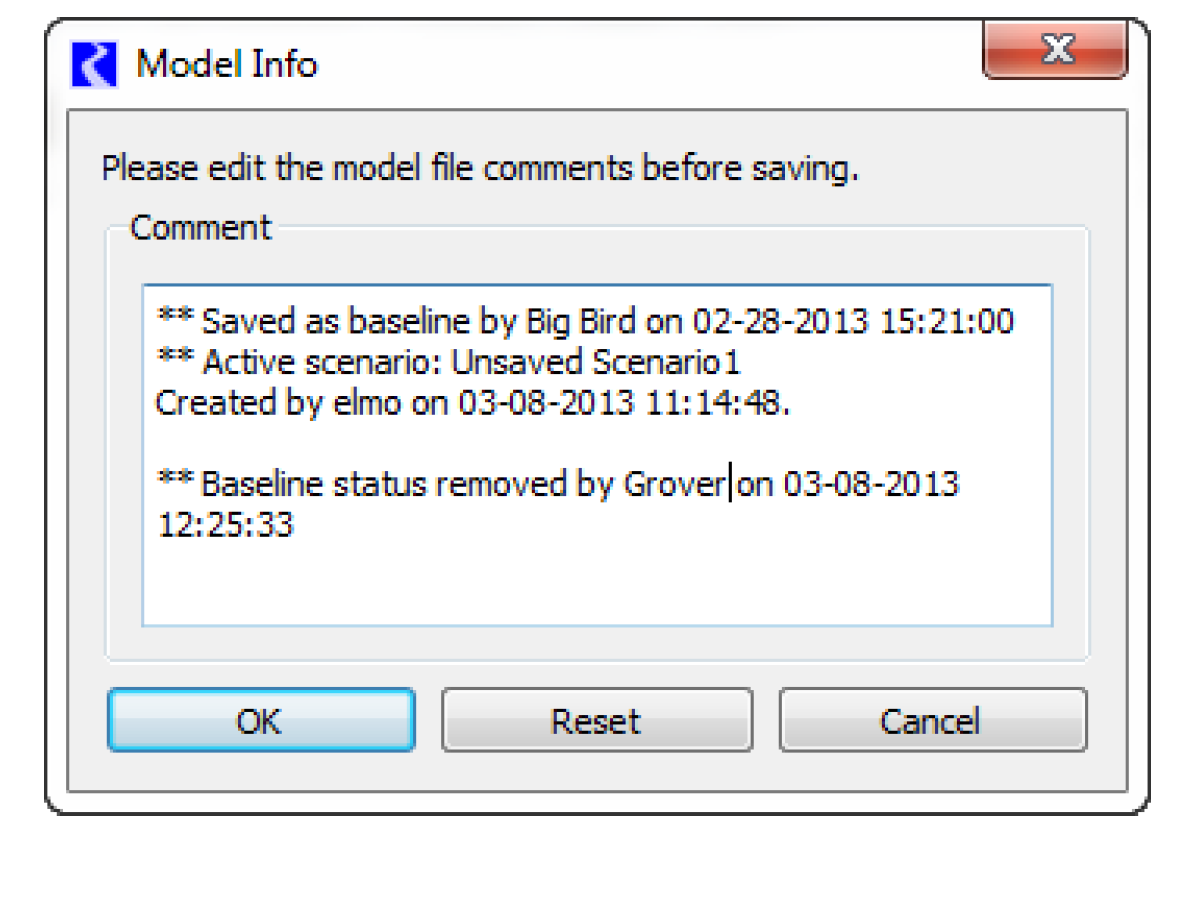
Revised: 11/11/2019